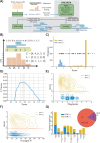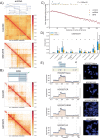Breakage fusion bridge cycles drive high oncogene number with moderate intratumoural heterogeneity
- PMID: 39929823
- PMCID: PMC11811125
- DOI: 10.1038/s41467-025-56670-8
Breakage fusion bridge cycles drive high oncogene number with moderate intratumoural heterogeneity
Abstract
Oncogene amplification is a key driver of cancer pathogenesis. Both breakage fusion bridge (BFB) cycles and extrachromosomal DNA (ecDNA) can lead to high oncogene copy numbers, but the impact of BFB amplifications on intratumoral heterogeneity, treatment response, and patient survival remains poorly understood due to detection challenges with DNA sequencing. We introduce an algorithm, OM2BFB, designed to detect and reconstruct BFB amplifications using optical genome mapping (OGM). OM2BFB demonstrates high precision (>93%) and recall (92%) in identifying BFB amplifications across cancer cell lines, patient-derived xenograft models, and primary tumors. Comparisons using OGM reveal that BFB detection with our AmpliconSuite toolkit for short-read sequencing also achieves high precision, though with reduced sensitivity. We identify 371 BFB events through whole genome sequencing of 2557 primary tumors and cancer cell lines. BFB amplifications are prevalent in cervical, head and neck, lung, and esophageal cancers, but rare in brain cancers. Genes amplified through BFB exhibit lower expression variance, with limited potential for regulatory adaptation compared to ecDNA-amplified genes. Tumors with BFB amplifications (BFB(+)) show reduced structural heterogeneity in amplicons and delayed resistance onset relative to ecDNA(+) tumors. These findings highlight ecDNA and BFB amplifications as distinct oncogene amplification mechanisms with differing biological characteristics, suggesting distinct avenues for therapeutic intervention.
© 2025. The Author(s).
Conflict of interest statement
Competing interests: V.B. is a co-founder, consultant, SAB member and has equity interest in Boundless Bio and Abterra, and the terms of this arrangement have been reviewed and approved by the University of California, San Diego in accordance with its conflict of interest policies. P.S.M. is a co-founder, chairs the scientific advisory board (SAB) of and has equity interest in Boundless Bio. P.S.M. is also an advisor with equity for Asteroid Therapeutics and is an advisor to Sage Therapeutics. H.Y.C. is a co-founder of Accent Therapeutics, Boundless Bio, Cartography Bio, and Orbital Therapeutics, and is an advisor to 10X Genomics, Arsenal Biosciences, Chroma Medicine, and Spring Discovery. J.J.Z. is co-founder and director of Crimson Biopharm Inc. and Geode Therapeutics Inc. LBA is a co-founder, CSO, scientific advisory member, and consultant for io9, has equity and receives income. The terms of this arrangement have been reviewed and approved by the University of California, San Diego in accordance with its conflict of interest policies. LBA is a compensated member of the scientific advisory board of Inocras. LBA’s spouse is an employee of Hologic, Inc. LBA declares U.S. provisional applications with serial numbers: 63/289,601; 63/269,033; 63/366,392; 63/412,835 as well as international patent application PCT/US2023/010679. LBA is also an inventor of a US Patent 10,776,718 for source identification by non-negative matrix factorization. K.H. is a former employee of Boundless Bio, Inc. The remaining authors declare no competing interests.
Figures





Update of
-
Breakage fusion bridge cycles drive high oncogene copy number, but not intratumoral genetic heterogeneity or rapid cancer genome change.bioRxiv [Preprint]. 2023 Dec 13:2023.12.12.571349. doi: 10.1101/2023.12.12.571349. bioRxiv. 2023. Update in: Nat Commun. 2025 Feb 10;16(1):1497. doi: 10.1038/s41467-025-56670-8. PMID: 38168210 Free PMC article. Updated. Preprint.
References
-
- Krijgsman, O., Carvalho, B., Meijer, G. A., Steenbergen, R. D. M. & Ylstra, B. Focal chromosomal copy number aberrations in cancer—needles in a genome haystack. Biochim. Biophys. Acta BBA Mol. Cell Res.1843, 2698–2704 (2014). - PubMed

